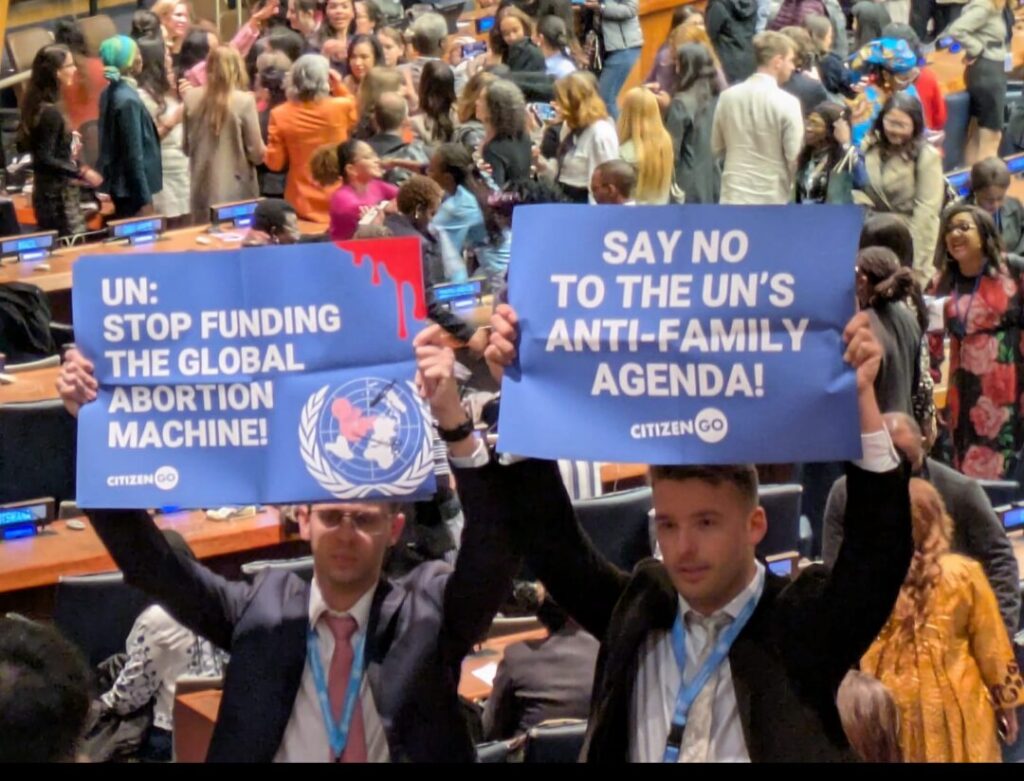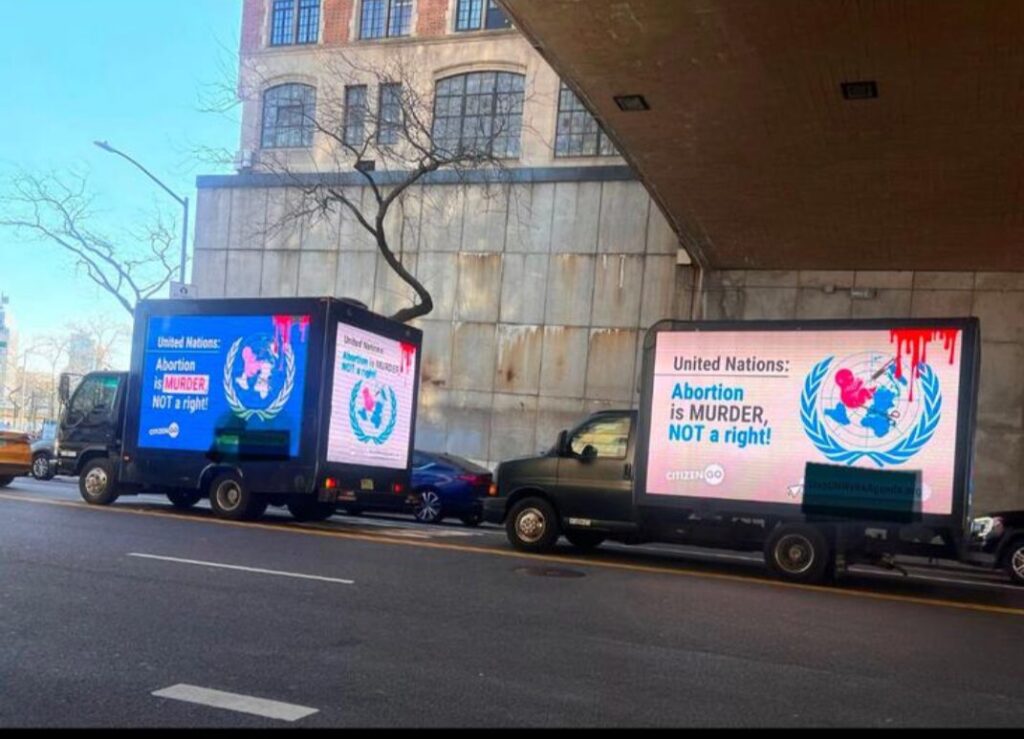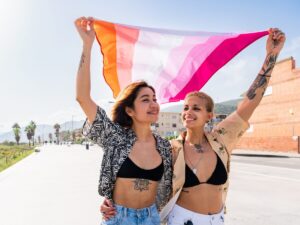This year’s Commission on the Status of Women (CSW69), hosted in New York at the UN headquarters, celebrated the 30th anniversary of the Beijing Declaration, considered the most progressive blueprint ever for advancing women’s rights.
At events centred on gender equality, women’s rights, and empowerment, you would expect the prestigious UN to be full of feminists from all over the world, eager to have their voices heard and a seat at the decision-making table.
However, the irony of this “global” gathering is that behind the feminist facade, it maintains the elitist and exclusive nature of the UN, with anti-rights groups rearing their ugly heads. Some circled the main buildings with cars brandishing the slogans “Abortion is murder, not a right!”
Meanwhile, many anti-rights movements and White feminists infiltrated and dominated spaces that others are left to only dream of entering.
Running in parallel to the main UN events were panels and smaller-scale talks in the Church Center building, across the street from the UN.
Civil society organisations are invited to book a space to host their panel for a fee of around $550, a large price to pay for organisations that struggle to secure small-scale funds to sustain their work. Those who did pay were not always aligned with the intersectional feminist agenda.

White feminism takes over
A panel of women from the nonprofit, US Women Connect, hosted an event on connecting local organisations to global networks. During their 90-minute slot, they rambled on about the struggles of White women in America, occasionally proudly peppering in the term LGBTQ+, a favourite way for White feminists to show their “truly progressive” nature.
Speaker Rana Lehr-Lehnardt, a professor at the University of Missouri-Kansas City School of Law, attempted to create a moment between her spectators.
“Look around this room and tell me what you notice,” she asked. Murmurs filled the air, of “no men” or “where are the men.” The most blatant issue that came to my mind was the fact nearly all the women there were White.
Visa and passport privilege is something that did not cross the minds of the panel plagued with White feminist mentality as they continued discussing domestic abuse, lack of women leaders,
and other issues; they consistently failed to mention women of Colour, indigenous people, and other marginalised communities.
To highlight the panel’s lack of an intersectional feminist approach, a Nigerian woman, Foluke Ademokun, spoke up at the end. “Although I am here to learn from US women and their systems, I hope when you refer to feminist struggles, you realise feminism is a global issue and in countries like Nigeria we are facing obstacles to secure the rights women in the US are guaranteed,” she poised.
The comment shifted the air in the room from what was a nauseatingly stereotypical White woman cliché energy of “girl power, look at us go” to new and necessary unchartered territories. The speakers shifted in their seats and scrambled to give what they thought was a good “we are one” response but came off as defensive and unprepared.

It was an undeniable fact that the more you looked around these so-called international feminist spaces, the more you understood that “global” in the case of many UN events is reduced to White people from Western societies or the financially privileged.
Meanwhile, feminists from global majority countries, the ones on the frontlines through crisis after crisis, were largely eliminated, from Sudan, Palestine, Haiti, Afghanistan, and beyond. The women who warmed their seats had most likely never stepped foot in one of these countries, yet they held heavily stamped passports, spoke on their behalf, or conveniently forgot to mention them at all.
When women from the global majority were given the mic, their time was cut short to allow plenty of room for ambassadors, who generally regurgitated the same diplomatic spiel. These women were tokenised, a completed tick box for the UN used to demonstrate their “diverse” and “indiscriminate” agenda.

Where are the men?
That being said, Professor Lehr-Lehnardt did have a point. The lack of men was undoubtedly obvious, with nearly all seats filled by women except one or two men, maximum. That was until you attended a high-level talk inside the UN; then, it was notable to see men take hold of the space, with women dotted around between them.
A tragic truth that men attend events where they are the speakers and feel in power, but when it’s finally the women’s turn, the men are nowhere to be seen.
Hosting parallel event panels became a way for anti-rights groups to spread their agenda, trying to subtly sandwich their rhetoric between data on how many women they supposedly help.
Caritas Internationalis, World Women’s Observatory, Scalabrini International Migration Network, and the Centre for Women’s Studies and Interventions, among others, hosted a well-attended panel: “Women and Forced Migration: Addressing Challenges and Promoting Rights.”
President General of World Union of Catholic Women’s Organisations, Mónica Santamarina, spoke about their projects to support women asylum seekers and refugees integrate and rebuild their lives, while effectively denouncing harsh immigration tactics.
In the same breath, Santamarina used air quotes for what she described as “so-called reproductive rights” of these women, naming education, access to contraception, and abortions as confusing. Instead, she noted their organisation chooses to “emphasise the importance of motherhood,” to the women who seek refuge from unthinkable trauma including sexual assault with many survivors impreganted by their rapist.
In the eyes of Santamarina, the panel, and perhaps even more concerningly, the 40 or more people listening intently, women’s rights were something they could pick and choose based on what aligned with their morals, seeking out women survivors to manipulate and force their agenda upon them. CSW is a microcosm of what all intersectional feminists are facing on a wide scale: bureaucracy, lack of funding, unequal opportunities, and colonial structures. It brings a question to the forefront: How can real change be made if fundamental institutions embody the very obstacles we are fighting?















